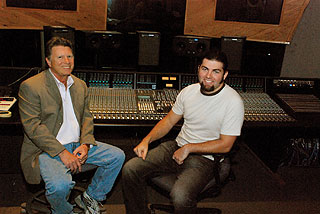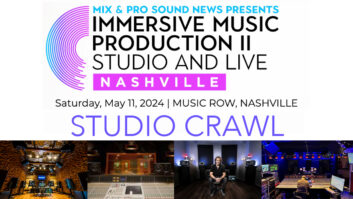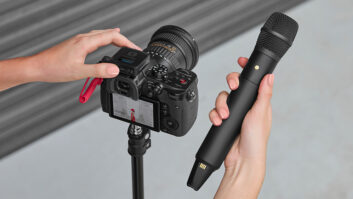
Williams with grad student/engineer/writer Tim Hall.
At a chance meeting at our Mix Nashville event in May, we learned of this real-world recording project going on at Middle Tennessee State University. We asked graduate student Tim Hall to write about it for Mix’s annual audio education issue.
— Eds.
It was just another day at MTSU until 4 p.m. rolled around and 40 students, a string section, a drum corps, bass player, improvised choir, vocalist, two Grammy Award-winning engineer/producers, a few camera operators and myself walked into Studio B with only four hours to record every element of a song our professor, Dick Williams, had chosen to release internationally. None of us had met or rehearsed together, and we didn’t know exactly what we were about to record.
But we had a student in the class with a great voice, Hannah Phillips, lined up to do vocals, one of the school’s string sections to perform strings, Lalo Davila and his drum corps to lay down the beat and a pseudo-band pieced together from the rest of the class ready to put down some tracks. At one point, Dick announced that he wanted to record a choir. We didn’t have one, so he asked the class, “Who can sing?” At least eight people raised their hands; Dick told them that they’re our new choir and to get ready to record.
The vibe going into the session was an interesting mix of excitement and confusion — with a hint of the frantic from my end. Thankfully, industry pros John Lawry, John Jaszcz and Grant Greene were there to coach us — all I had to do then was to set up the console for tracking, show Grant and John Jaszcz how everything worked, do the patching and then come up with a guitar part for the song while setting up to record it. Did I mention we started out with only four hours of studio time? We had to keep reminding ourselves that this was a class.
It all began when former VP of promotions at EMI Dick Williams came to teach a record label course at Middle Tennessee State University and decided to focus on international synergy. He had been a guest speaker the year before, and it got him thinking about giving back to the industry. After meeting with Chris Haseleu, chair of the Recording department, he signed up for the year, working pro bono; actually, they did pay him a dollar. His goal was to bring real-world experience to the classroom and to put out a product on the relatively new MTSU record label. He had the student and industry talent lined up, but he needed a song.
“I was channel-surfing one evening and stumbled upon a rerun of the movie American Beauty,” Williams recalls. “In a poignant scene, Annie Lennox sings the Neil Young song ‘Don’t Let It Bring You Down.’ The song was stuck in my head for several days. Lyrically, it was an accurate depiction of the direction our economy was headed. And, musically, I could hear a similar arrangement, with some embellishment by incorporating the drum line from the university marching band and the string section from the school’s orchestra. Most importantly, a Canadian artist wrote it. So it would fit the criteria necessary to demonstrate international synergy.”
Once he had the song, Dick still had to get the players, and he found that it’s not always easy to get every department at a big university working together. “I was naïve to university protocol and idiosyncrasies,” he says with a laugh. “I’m a businessman, and when I see something that needs to be done, I figure out a way to get it accomplished. So I e-mailed Chris Haseleu to secure the musicians from the drum line and string players. He put me in touch with George Riordan, the director of the School of Music. George couldn’t have been nicer, and was a great help. He connected me with Lalo Davila, the percussion instructor for the drum line and provided me with the necessary string players. We made up a choir out of our class members, and we got Tim [author] and Michael Dinse playing lead and bass guitar. In total, 40 students from the university performed on the track. It may have looked like an overly ambitious endeavor at the onset, but it was just another day at the office for pros like John Jaszcz, Grant Greene and John Lawry. I was very grateful that faculty member Cossette Collier and grad student Eric Jackson filmed the recording, which can be seen at our Website, www.mtsurecords.com.”

MTSU students gather with label exec/teacher Dick Williams to track their version of Neil Young’s song “Don’t Let It Bring You Down.”
Once the players and times were secured, it was off to Studio B. Grant and I set some mics for recording strings with the help of a couple students while John Lawry began working on the string parts with the players. Grant wanted to use two Neumann TLM 170s set to omni as a spaced pair for the main room mics, so we set them up about eight to nine feet in the air, approximately six to 10 feet in front of the section and about 10 feet apart. We put those through a pair of Millennia mic preamps that sounded good enough to go straight into Pro Tools. Then we used an ORTF pair of Sennheiser MKH 20s placed in the center of the section a few feet behind the conductor and a little bit above his head, also through a pair of Millennia mic preamps.
Studio B has a great-sounding large tracking room. Once John Lawry had them all together, the strings were starting to work well with the song. We didn’t have to EQ or compress anything; it was already good and we wanted to save that for the mix.
I’ve had a lot of success recording drums (especially hard rock) in the main room there so it was no surprise that when the drum section came in and played together, it was huge without being overpowering. We just used the same mics that we used on the strings for the drum corps minus the MKH 20s. All we had to do was raise them a little higher, and it sounded just fine.
After the whole ensemble played their parts, we had the first chair in the drum corps play the same part again in various places around the room to help add a little more punch. Then we set up the studio’s Pearl Master Series kit for him to play. It was a straightforward setup with a D112 on the kick, SM57 on the snare top and bottom, Sennheiser 421s on the toms, Neumann KM 140 on the hat and AKG 414s for the overheads. Here’s where we got to take advantage of the newly installed 48-channel SSL Duality in the control room and used all onboard pre’s and EQs before hitting Pro Tools.
Now with a solid drum track down, Mike Dinse played a little bass through a Countryman DI into a Martech MSS-10 mic pre and a Summit Audio TLA-100 leveling amplifier that Grant and John Jaszcz had brought over. This gave the bass track a lot of warmth and body. The compressor and pre really helped fill out the low end nicely without getting muddy; this would help later when we worked on the lead vocal.
In the midst of all of this and me running around making sure everything functioned properly, I glanced down to notice the clock creeping ever so quickly to the end of our four-hour session with a lot of things left to be done. Thankfully, the person who had booked the studio immediately after our session ended up not being able to use the time, giving us an extra four hours to record!
Now we had time for Hannah to perform the lead vocal in a more intimate and lower-stress setting. John Lawry had brought in a Mojave Audio MA-200 tube mic that complemented her vocal style well, and together with John Jaszcz, they helped Hannah crank out a soulful performance that really carried the song.
Hannah did a few doubles here and there on a few things, and then the impromptu choir of students in the class stepped into the tracking room to do some backgrounds. Using the same two mics we basically had been using all day, we repositioned the Neumann 170s to capture the group. After John Lawry did a little coaching, they were ready to record, with Junice belting out a strong “Take me to church” ad lib on the last chorus that made John Jaszcz happy.
I ended up not playing any guitar that day because we didn’t have a lot of time left, not to mention I was too focused on figuring out why the track buses on the right side of the console weren’t working, and why channel 20 was out of polarity. I decided to take the track home to sit with the song and really get my mind in the right mood for the part. I later recorded the guitars on my LE rig. The axe of choice was my LTD MH 301 through a Crate Blue Voodoo head into a Mesa 4×12 cabinet, and even though it’s a rig ideal for metal, I discovered that I have a clean channel and used it for once.
I used an M-Audio Solaris condenser mic with an SM57 through a pair of Neve preamps I had checked out from MTSU in my lavish and luxurious “studio” (aka, second bedroom in my apartment). After a few noise complaints from my neighbors and the cops that later resulted in a warning of eviction (not joking), I managed to get what I wanted onto the track.
With all the tracks in, we relied on John Jaszcz’s Grammy Award-winning skills to mix the song at his place before it would get sent to Bob Ludwig for mastering. John Jaszcz put the song together perfectly and had each element sitting nicely within the track. He did a portion of the mix in the box using EQs and compressors by McDSP with some Waves SSL emulations and a few things by PSP, including that company’s vintage gear emulations. The mix was then summed through a Raindirk Symphony console for that analog sound.
When everything was said and done, and Ludwig sent us back the master with a few different compression schemes from which to choose, Dick made his final choice and the song went on to duplication and distribution. It was a great learning experience for everyone who participated in the project, but that wasn’t the end of the recording plans for MTSU Records. We still had a bunch of artists to record that semester, not to mention a new semester on the horizon. All I know is I had the opportunity to work with a lot of very talented and well-respected individuals in the music business that I’ll never take for granted because an education like this is hard to come by.
Dick Williams and the Class
Former VP of promotions at EMI, Dick Williams has had a long and successful career with a hand in many hit songs from artists such as David Bowie, Lynyrd Skynyrd, Elton John, Wendy Moten and the list goes on. I had the pleasure of assisting his class last term by performing a lot of the engineering duties the class required, as well as acting as the temporary president of the newly renamed record label, MTSU Records. During the process, I gained much insight from the numerous guest speakers Dick brought in, as well as getting a first-hand look at what he wanted to do with the class.
Being that this was your first time teaching in a class setting such as this, what kind of things did you want to bring to the table?
My first inclination was to draw upon some of the gifted students at MTSU to fill my classroom. Ironically, as the semester was coming to a close, each of the recording classes put on display their most significant work in a two-hour listening session. This gave me a glimpse of the talent pool that I would be able to tap from. As you know, this is how you and Hannah Phillips were chosen to be the nucleus of the class.
The next step was to create an agenda that none of the other faculty members would have taught. So I chose to demonstrate international synergy. To do this with some degree of effectiveness, I called upon my friends John Jaszcz and Grant Greene to help me record something commercially viable. John and I had worked on several recordings together, and Grant, his assistant, is an alumnus of MTSU. They worked frequently at a studio owned by producer/arranger John Lawry.
How many people were interested in taking your class, and how did that inaugural class go?
After opening my class registration to anyone in the school interested in it, 42 students enrolled. To quickly recognize each of the student’s capabilities, I devised an aptitude test covering a variety of subjects. I told the students on the first day of class, “You’re not going to be graded on the results of this test. I just want to know your knowledge of the music industry.”
I was pleasantly surprised to see such a diversified assemblage of students. There were those that aspired to be recording artists; others wanted to be producers, engineers, musicians, publishers, managers, record executives and songwriters. Some of them just took the class to gain a better understanding of the music business.
On my second class, I asked, “Who among you wish to be considered as artists that will have recording privilege?” Several students raised their hands. So I decided to have an audition on the following day of class. As the students entered the room, one of them, Jeffery Owens, pulled me aside and asked if it would be okay for him to sing a cappella as he didn’t have a recording demo or music track to accompany him. There were eight students that wanted to be considered. When I asked who would like to go first, Jeffery volunteered. I was so moved by his courage; it really set the pace of my class for the entire semester. Everyone wanted to contribute in some way.
It really was something unique, getting all these students and the different departments working together. But you also went outside?
The success of the recording experience inspired me to call upon several of my former clients and music business colleagues to offer the students some guidance, motivation and knowledge from their personal experiences. Therefore, in addition to having a Grammy Award-winning production team, the students heard from recording artist Wendy Moten; Internet marketing specialist Greg Markel; CAA booking agent John Huie; world-renowned rock photographer Robert Knight; Seinfeld producer Tim Kaiser; guitar prodigy Tyler Bryant; my former promotion staff member and a current professor at Georgia State University Jim Davenport; and the former head of EMI Worldwide, Rupert Perry.
To cap off my semester, Bob Ludwig mastered our class recording project, and Deane Cameron, president of Capitol Records in Canada, agreed to press our CD and make it available to territories around the world. Now I’m prepared to do it all over again with a few additional surprises.







